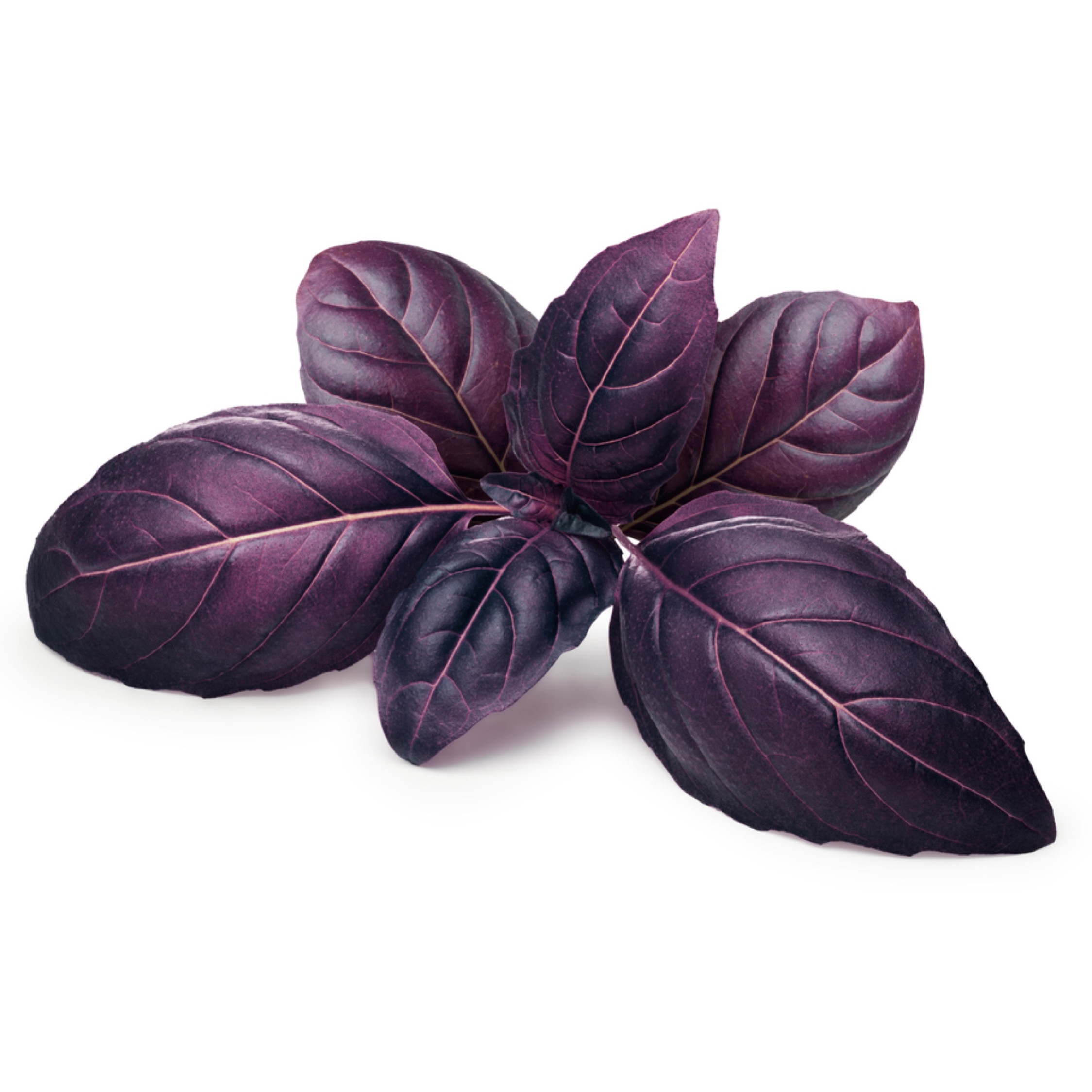When it comes to herbs that truly capture the essence of flavor and fragrance, few can rival the incredible versatility and charm of basil. This delightful herb, with its vibrant green leaves and distinctive aroma, has been a staple in kitchens and gardens for centuries. While most of us are familiar with the classic sweet basil that reigns over pesto and Caprese salads, there exists a captivating array of basil varieties, each with its own unique characteristics and culinary applications.
In this guide, we will reveal the different basil varieties to expand your horizons and elevate your dishes with the tantalizing flavors and aromas of basil!
1. Sweet Basil

Sweet basil, also known as Ocimum basilicum, holds a special place in the culinary world. It has a royal reputation, and its name tells us why. “Ocimum” comes from the Greek word “okimom,” which means aromatic herb, and “basilicum” stems from “basileus,” the Greek word for king. So, you can say it’s the king of herbs!
What makes sweet basil even more impressive is its rich history. It has been cherished by many ancient civilizations, including the Egyptians, Greeks, and Romans. Believe it or not, it has been cultivated in India for over 5,000 years! The herb found its way to Europe from India around the late 1500s, spreading its aromatic goodness.
When it comes to basil, there’s no shortage of variety, but sweet basil takes the crown as the most popular. With over 60 different types to choose from, it caters to the taste buds of Italian, Indian, Greek, Southeast Asian cuisine lovers, and more.
🟩 Characteristics
- Stem and leaf: The stems are square-shaped, and the leaves grow on opposite sides. The leaves are rounded, slightly cupped, and taper into a point at the tip. The color is generally light green, but some varieties have reddish or purplish leaves.
- Height: Basil stems can grow between 12 and 50 inches (30.5 to 125 centimeters), depending on the variety and growing conditions.
- Flower appearance and seed formation: The flowers are small and usually white, arranged along a spike that grows from the tip of the stem. After pollination, the flower falls off, and four round, dry structures called achenes develop. Each achene contains a small, dark, edible seed.
- Culinary uses: Sweet basil is a versatile herb used in various culinary dishes. It is commonly found in pesto, Caprese salad, tomato-based sauces, Italian cuisine, Thai dishes, infused oils and vinegars, and herbal teas. Its aromatic flavor enhances the taste of these dishes and adds a fresh touch to recipes.
2. Genovese Basil
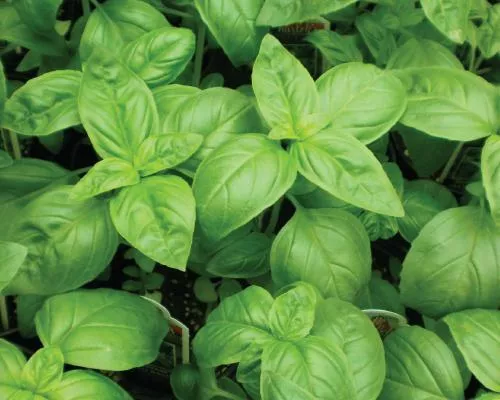
Genovese basil is a delightful variety of sweet basil that’s thought to have originated in India. It’s also prominent in different parts of Asia and Africa. Interestingly, the Romans, way back in ancient times, brought basil to the Liguria region. They held it in high regard for its healing properties and considered it a valuable herb.
In fact, the resourceful Romans even came up with an early version of the famous Genovese basil sauce, known as moretum. They used it as a spread, combining olive oil, cheese, and herbs. This sauce paved the way for the modern pesto we know today.
Fast forward to the early 1800s in Genoa, and that’s when the modern pesto, made with the flavorful Genovese basil, was introduced. It became a hit, and people couldn’t resist the aromatic and vibrant taste of this basil variety in their pesto creations.
🟩 Characteristics
- Leaf size and color: The leaves of Genovese basil are medium to large in size. They have an attractive, vibrant green color that adds visual appeal to dishes and herb gardens.
- Height: Genovese basil plants typically grow to a height of about 2 to 3 feet (60 to 90 cm). They have a bushy and compact growth habit, making them suitable for both outdoor gardens and container cultivation.
- Leaf texture: The leaves are smooth in texture, which makes them pleasant to touch and easy to work with in various culinary preparations.
- Culinary uses: Genovese basil enhances various dishes like Caprese Salad, Pesto Sauce, Margherita Pizza, Bruschetta, Tomato and Mozzarella Panini, Tomato Basil Soup, and Pasta Primavera. Its fresh aroma and flavor elevate these dishes to new heights.
3. Thai Basil
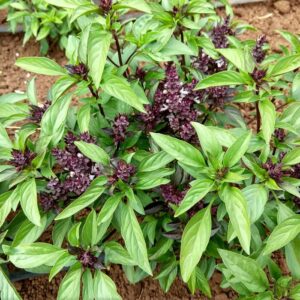
Belonging to the mint family, Thai basil, scientifically known as Ocimum basilicum var. thyrsiflora, is an intriguing herb with distinct characteristics. It forms part of a unique trio of basil cultivars, including sweet and holy basil. Thai basil, cultivated as an Asian variety of sweet basil, stands out for its spicier flavor and impressive heat tolerance during cooking. One noteworthy Thai basil type is Siam Queen, known for its larger leaves and unmistakable black licorice undertones.
The confusion often arises when distinguishing Thai basil from holy basil, also referred to as Thai holy basil. Despite their similar names, these two herbs actually belong to different species and offer contrasting taste profiles. Thai basil captivates the palate with its robust and sweet yet spicy notes reminiscent of anise, while holy basil carries a peppery essence evoking cloves. It’s an intriguing case of mistaken identity!
🟩 Characteristics
- Leaf appearance: Thai basil has elongated and pointed leaves that are typically deep green and glossy in appearance. The leaves are slightly thicker if you compare it to other basil varieties.
- Height: Thai basil plants can reach a height of about 1 to 2 feet (30 to 60 cm) when fully mature. They tend to grow with an upright and bushy habit, forming dense clusters of foliage.
- Aroma: Thai basil emits a captivating and aromatic scent. Its fragrance is a delightful blend of mint, basil, and anise, adding a pleasant aromatic element to dishes.
- Culinary uses: Thai basil is a staple ingredient in Southeast Asian cuisine, particularly Thai, Vietnamese, and Laotian dishes. It adds a distinct and authentic flavor to various recipes, including curries, soups, stir-fries, salads, and even beverages.
4. Lemon Basil
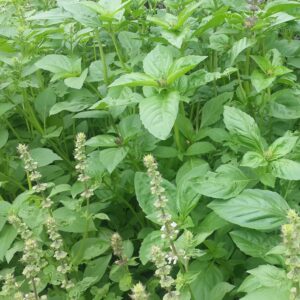
Lemon basil, also known by its scientific name Ocimum X citriodorum, is a specific variety of basil that offers a distinct lemony flavor and fragrance. It is a hybrid herb that belongs to the mint family, Lamiaceae. Lemon basil is characterized by its bright green leaves and a refreshing citrus scent, reminiscent of lemon zest. The leaves of lemon basil are typically elongated and serrated, similar to other basil varieties.
The flavor of lemon basil is what sets it apart. It carries a unique combination of citrus notes and the classic basil taste, providing a zesty and tangy twist to dishes. The lemony aroma and taste make it a popular ingredient in various culinary creations, including salads, dressings, marinades, sauces, and herbal teas. Lemon basil adds a refreshing and vibrant element to both sweet and savory dishes.
🟩 Characteristics
- Leaf appearance: The leaves of lemon basil are typically bright green and elongated, similar to other basil varieties. They have a slightly serrated edge, adding texture to its visual appeal.
- Growing conditions: Lemon basil is an annual herb that thrives in warm and sunny conditions. It requires well-drained soil and regular watering to ensure healthy growth. It can be grown in home gardens or containers, allowing easy access to fresh leaves for culinary use.
- Culinary uses: Lemon basil is a versatile herb used in various culinary applications. It can be used fresh or dried and is commonly added to salads, dressings, marinades, sauces, and herbal teas. It pairs well with seafood, poultry, vegetables, and fruits, enhancing their flavors with its citrusy profile.
5. Lime Basil
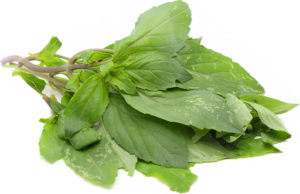
Lime basil is considered a close relative of the more commonly known lemon basil. While it is primarily cultivated for culinary purposes, lime basil also holds value as an ornamental plant and is even recognized for its potential as a natural insect repellent.
In addition to its culinary applications, lime basil is cherished for its aromatic qualities. The plant’s essential oil can be extracted and utilized in various products such as soaps, candles, cosmetics, and aromatherapy. It is said to blend well with floral, spicy, or citrusy essential oils, such as mandarin, creating a delightful and refreshing fragrance.
Lime basil’s unique attributes, including its hairy stems and distinct aroma, make it a fascinating addition to the world of herbs. Its versatility as a culinary ingredient, ornamental plant, and potential insect repellent further contributes to its appeal among gardening enthusiasts and those seeking natural alternatives.
🟩 Characteristics
- Leaf appearance: Lime basil is recognized by its hairy stems, giving it a slightly textured and unique appearance compared to other basil varieties. The leaves are typically bright green and can be oval or lance-shaped, similar to other basil plants.
- Ornamental value: Lime basil’s unique appearance and aromatic properties also make it a popular choice for ornamental gardens. Its textured stems and vibrant green foliage can provide visual interest and enhance the overall aesthetics of a garden or landscape.
- Culinary uses: Lime basil is primarily cultivated for its culinary applications. Its distinctive lime flavor makes it an excellent addition to salads, dressings, marinades, and seafood dishes. It pairs well with various ingredients, adding a citrusy punch to recipes.
6. Holy Basil
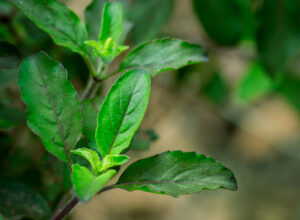
Holy basil is native to the Indian subcontinent and is commonly found in tropical regions of Southeast Asia. It has a strong, distinct aroma and flavor, with a slightly spicy and peppery taste. In traditional Ayurvedic medicine, holy basil has been used for centuries due to its numerous health benefits. It is believed to have adaptogenic properties, helping the body cope with stress and promoting overall well-being. Holy basil is also known for its antioxidant, anti-inflammatory, and antimicrobial properties.
It’s important to note that while holy basil is generally safe for consumption, it may interact with certain medications or have side effects in some individuals. If you have any specific health concerns or are considering using holy basil for medicinal purposes, it’s advisable to consult with a healthcare professional or an Ayurvedic practitioner.
🟩 Characteristics
- Leaf appearance: The plant has distinct green leaves and produces small white or purple flowers.
- Growing conditions: Holy basil is relatively easy to grow and cultivate. It is a perennial plant in tropical regions and an annual in colder climates. It thrives in warm and sunny conditions and requires well-drained soil. Holy basil is often grown in home gardens or as potted plants.
- Culinary uses: Holy basil leaves are commonly used in cooking, especially in South Asian cuisine. They add a distinct flavor and aroma to dishes, similar to that of cloves or anise. Holy basil is used in teas, curries, soups, and stir-fries.
7. Cinnamon Basil
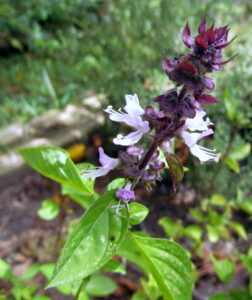
Cinnamon basil is a variety of basil that is popular for its distinct aroma and flavor reminiscent of cinnamon. When crushed or rubbed, the leaves emit a delightful fragrance that combines the sweet and warm notes of cinnamon with the herbal aroma of basil.
In terms of taste, cinnamon basil offers a flavorful blend of spicy, sweet, and slightly peppery undertones. It imparts a warm and aromatic quality to dishes, adding depth and complexity to various culinary creations. You can use the leaves fresh as a garnish or ingredient in Thai cuisine, particularly in curries, stir-fries, soups, and salads.
🟩 Characteristics
- Leaf appearance: Its leaves are elongated, narrow, and slightly serrated, with a deep green color and prominent veins. The plant’s stems are often purplish or reddish, adding to its visual appeal.
- Growing conditions: Cinnamon basil is an annual herbaceous plant, which means it completes its life cycle within a single growing season. It prefers warm climates and thrives in full sun or partial shade. It requires well-draining soil and regular watering to maintain healthy growth.
- Culinary uses: Cinnamon basil is widely used in Thai cooking, where it is valued for its flavor and aroma. The leaves are usually present on curries, stir-fries, soups, and salads, providing a distinctive twist to these dishes. You can also use it as a fresh garnish or made into infused oils or vinegar.
8. Purple Basil
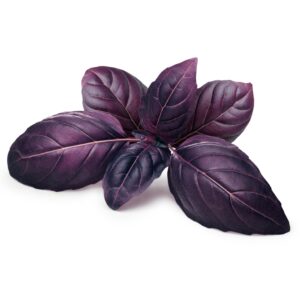
Purple basil is a variety of basil that features vibrant purple or dark burgundy leaves. It is a cultivar derived from the sweet basil plant and is primarily grown for ornamental purposes, although it is also edible and shares similar flavor characteristics with other basil varieties.
Purple basil adds a unique visual appeal to herb gardens, landscaping, and culinary dishes. Its deep purple leaves create a striking contrast when paired with green basil varieties or other herbs. In terms of flavor, purple basil typically retains the traditional sweet and slightly spicy taste found in other basil types, although it may vary slightly depending on the specific cultivar.
🟩 Characteristics
- Leaf appearance: Purple basil leaves often have a ruffled or serrated appearance, adding an attractive texture to the plant. The shape of the leaves is similar to that of other basil varieties, with an oval or lanceolate shape. The leaves are typically a deep, rich shade of purple throughout, although there may be some variation depending on the specific cultivar.
- Growing conditions: Purple basil, like other basil varieties, prefers warm climates and thrives in full sun. It requires well-drained soil and regular watering. You can grow it from seeds or propagate through stem cuttings.
- Culinary uses: Purple basil is edible and can be used in various culinary applications. Its striking color makes it an attractive garnish for salads, soups, and desserts. It can also be used in pasta sauces, pesto, infused oils, and as a flavorful addition to drinks like lemonade or cocktails.
9. Greek Basil

Greek basil is a popular herb that belongs to the mint family, Lamiaceae. It is native to the Mediterranean region, including Greece. Greek basil is highly valued for its culinary uses and aromatic properties. The plant has a bushy growth habit, with dark green, glossy leaves that are often used in cooking. The leaves are oval-shaped and have a slightly peppery, yet sweet flavor. They are commonly used fresh or dried to add a distinctive taste to various dishes.
Greek basil is also popular for its medicinal properties apart from its culinary uses. It has health benefits due to its essential oils, antioxidants, and various nutrients. Traditional medicine has utilized Greek basil to treat digestive issues and respiratory problems, as well as a natural insect repellent.
🟩 Characteristics
- Leaf appearance: Greek basil typically has dark green, glossy leaves that are slightly smaller compared to other basil varieties. The leaves are oval-shaped with a pointed tip and have a smooth texture. The plant itself is bushy and can grow up to 18-24 inches in height.
- Growing conditions: Greek basil thrives in warm and sunny climates. It prefers well-drained soil and requires regular watering. It can be grown in pots or in garden beds. Regular pruning encourages bushier growth and enhances leaf production.
- Culinary uses: Greek basil is commonly used in Mediterranean and Greek cuisines. It adds a delightful flavor to dishes like salads, sauces, soups, stews, pasta, and pizzas. It pairs well with tomatoes, garlic, olive oil, and other herbs commonly used in Mediterranean cooking.
10. African Blue Basil
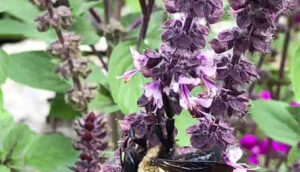
African blue basil is prominent because of its attractive purple stems and leaves, which have a strong, spicy aroma. This basil variety is also popular for its ornamental value, making it a popular choice in gardens and landscapes. However, it is also edible and you can use it in culinary applications like other basil varieties. The leaves have a slightly milder flavor compared to sweet basil and you can incorporate in salads, pesto, sauces, and other dishes.
🟩 Characteristics
- Leaf and flower appearance: The plant features purple stems and leaves, making it visually striking and ornamental. The leaves are broader and larger compared to those of sweet basil. The plant produces small, lavender-colored flowers that appear in clusters. These flowers are not only aesthetically pleasing but also attract bees and other pollinators to the garden.
- Growing conditions: African blue basil thrives in well-drained soil and prefers full sun to partial shade. It benefits from regular pruning to maintain its shape and encourage bushier growth.
- Culinary uses: While prized for its ornamental value, African blue basil is also edible. You can use the leaves in various culinary applications, such as salads, pesto, sauces, and other dishes. They add a unique flavor and visual appeal to recipes.
Bonus: Proper Storage for Basil
🟪 Basil Oil
Infusing basil leaves into oil is an excellent way to preserve their flavor. Wash and dry fresh basil leaves thoroughly. Place the leaves in a blender or food processor and add a neutral oil like olive oil. Blend until smooth. Pour the mixture into a sterilized glass jar and store it in a cool, dark place, away from direct sunlight. You can use the basil oil in dressings, marinades, or as a finishing drizzle for various dishes.
🟪 Herb Butter
Another delicious way to store basil is by making herb butter. Soften unsalted butter and finely chop fresh basil leaves. Mix the chopped basil into the butter, along with a pinch of salt and any other herbs or seasonings you desire. Roll the herb butter into a log using plastic wrap or shape it into a mold. Refrigerate or freeze the butter, and use it to enhance the flavor of bread, pasta, grilled meats, or vegetables.
🟪 Drying Method
Drying basil is a traditional preservation method. Gather fresh basil stems and tie them together with twine. Hang the bunches upside down in a well-ventilated area away from direct sunlight. Once the leaves are completely dry and crumbly, remove them from the stems and store them in an airtight container. You can use dried basils in soups, stews, sauces, and spice blends. Remember to crush the dried leaves before use to release their full flavor.
🟪 Basil Cubes
If you have excess basil, you can freeze it in ice cube trays with water or oil. Wash and dry the basil leaves, then finely chop or puree them in a blender. Spoon the basil into the compartments of an ice cube tray, filling them about halfway. Fill the remaining space with water or olive oil. Freeze the tray until the cubes are solid, then transfer them to a freezer bag or container. You can add these basil cubes directly to recipes when cooking to infuse the dishes with basil flavor.
🟪 Herb Vinegar
Infused herb vinegar is a versatile way to store and use basil. Sterilize a glass bottle and fill it with white or apple cider vinegar. Add fresh basil leaves, ensuring they are fully submerged in the vinegar. Seal the bottle tightly and store it in a cool, dark place for a few weeks to allow the flavors to develop. Strain the vinegar to remove the basil leaves, and use the infused vinegar in dressings, marinades, or as a tangy addition to various dishes.
🟪 Basil Salt
Make basil-infused salt to add a burst of flavor to your dishes. Place fresh basil leaves on a baking sheet and bake them at a low temperature (around 200°F or 95°C) until they are completely dry and crumbly. Allow the leaves to cool, then crumble them into a fine powder. Mix the basil powder with an equal amount of salt. Store the basil salt in an airtight container, and sprinkle it on roasted vegetables, grilled meats, or salads for an herbaceous touch.
🟪 Basil Tea
You can dry basil leaves and use it to make aromatic herbal tea. Harvest fresh basil leaves and rinse them thoroughly. Lay the leaves on a clean towel to dry naturally or use a food dehydrator. Once dry, store the leaves in an airtight container. To make basil tea, steep a tablespoon of dried basil leaves in a cup of hot water for about 5 minutes. Strain the tea and sweeten it with honey if desired. Basil tea is popular for its calming properties and you can enjoy it both hot and cold.
Final Words
And that’s a wrap, my friends! From the classic sweet basil to the intriguing African Blue basil, each type brings its own special something to your plate. And by using this guide, you can try out new recipes, mix and match flavors, and let your taste buds have a party! Whether you’re a budding chef, an avid gardener, or just someone who appreciates good food, the world of basil varieties will ignite your imagination and leave a lasting impression.
To know more about different spices and herbs, just click here!

